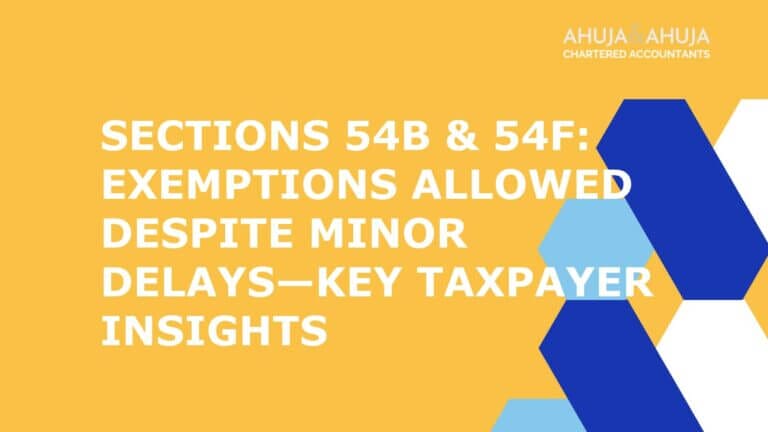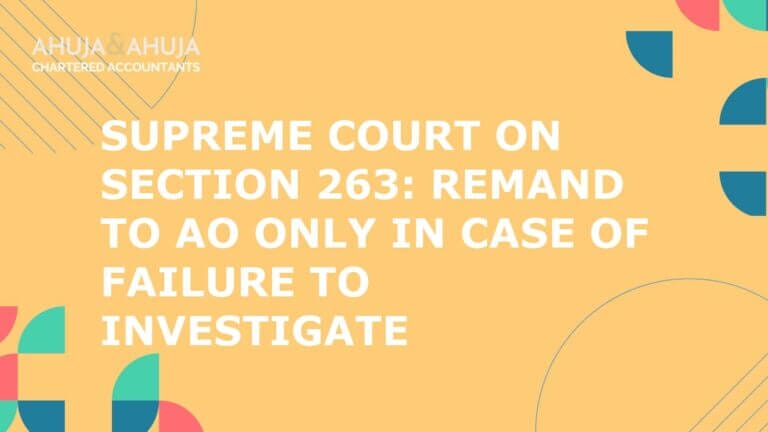Fresh SEZ Unit with New Capital Not Reconstruction — ITAT Allows 100% Deduction under Section 10AA
Fresh SEZ Unit with New Capital vs. Reconstruction — ITAT Chennai in Lotus Footwear on Section 10AA: What Truly Qualifies and How to Prove It
The recent ITAT Chennai ruling in the case of Lotus Footwear Enterprises Ltd. has brought much-needed clarity to the eligibility criteria for claiming a 100% deduction under Section 10AA for newly established SEZ units. The Tribunal’s message is clear: the statutory “newness” test—especially the 20% cap on transfer of used plant and machinery—trumps operational optics like employee movement or product overlap. In Lotus Footwear’s case, the deduction was denied because the value of transferred used machinery exceeded the 20% threshold (22.10% as of 31.03.2014). However, the Tribunal reaffirmed that the 10AA deduction must be computed before set-off of brought-forward losses and unabsorbed depreciation, following established precedents. The practical lesson? Fresh capital is essential, but arithmetic and documentation are decisive.
I. Context and Case Snapshot
The dispute was heard by the ITAT Chennai, A Bench, covering Assessment Years 2016–17 to 2019–20 (order dated 20.11.2024). The appellant, Lotus Footwear Enterprises Ltd. (India Branch), is a contract manufacturer for Nike-branded footwear, operating two units: LU1 (the original unit) and LU2 (set up in Cheyyar SEZ due to LU1 nearing full capacity).
The crux of the dispute:
- The Assessing Officer (AO) and Dispute Resolution Panel (DRP) held that LU2 was formed by splitting up or reconstructing LU1, citing transfer of used machinery exceeding 20%, employee movement, product overlap, and operational interdependence. They restricted the deduction to 50%.
- The assessee argued that LU2 was a fresh unit with substantial new investment, separate SEZ approval, and that the transfer of used machinery was below 20% if calculated at the commencement year and including capital work-in-progress (CWIP). They contended that employee and product overlap were not determinative.
- The ITAT ultimately denied 100% deduction for LU2, as the transferred used machinery exceeded the 20% threshold at the relevant date. However, it reaffirmed that the 10AA deduction is to be computed before set-off of brought-forward losses and unabsorbed depreciation, following the Supreme Court’s decision in Yokogawa India and the Madras High Court’s ruling in Amnet Systems.
II. Statutory Framework: The Legal Tests
Section 10AA provides a deduction for profits derived from SEZ units, but with a crucial caveat: the unit must not be formed by splitting up or reconstruction of an existing business, nor by transfer of used plant and machinery beyond permissible limits.
- Section 10AA(4)(iii) read with Explanation 2 to Section 80-IA(3):
- The value of previously used plant and machinery transferred to the new unit must not exceed 20% of the total value of plant and machinery in the new unit.
- Certain exceptions exist (e.g., imported second-hand machinery not previously used in India), but the computation is technical and must be substantiated.
- Non-statutory indicators—such as employee movement, product overlap, and operational linkages—are often cited but are not conclusive by themselves.
III. Issues for Determination
The Tribunal had to address several key questions:
- Is LU2 a “newly established” SEZ unit, or is it a result of splitting up or reconstruction of LU1?
- How should the 20% used machinery threshold be computed? What is the correct valuation date, and should CWIP be included?
- What is the weight of SEZ approvals, separate leases, and physical/functional demarcation?
- How should the 10AA deduction be sequenced vis-à-vis set-off of brought-forward losses and unabsorbed depreciation?
IV. Factual Matrix and Evidence in Lotus
Timeline and Asset Movements:
- Application to MEPZ: May 2013
- Production commenced: 02.04.2014
- AO treated the unit as “ready” on 31.03.2014
Key figures as of 31.03.2014:
- New machinery purchased: ~INR 11.99 crore
- Used machinery transferred: ~INR 3.40 crore
- AO’s ratio: 22.10% (used/total), exceeding the 20% cap
Assessee’s contention: If the ratio is computed in FY 2014–15 at commencement and CWIP is included, the percentage falls to 9.6%.
Operational markers:
- Separate lease with SEZ developer
- Separate SEZ approvals
- Physical segregation (compound walls, access points, utilities, ETP, warehouse, administration, etc.)
- Employee movement and product overlap (noted, but argued as incidental and not determinative)
V. Parties’ Arguments (Concise)
Assessee:
- Statute does not bar employee movement; product overlap is incidental; LU2 was set up due to capacity constraints in LU1.
- The 20% test should be computed at the commencement year, including CWIP, resulting in a ratio below 20%.
- SEZ approval and physical/functional independence should carry significant weight.
Revenue:
- The unit was “ready” as of 31.03.2014; the ratio exceeds 20%, triggering disqualification.
- Employee transfer and product overlap indicate extension of the existing business.
- CWIP cannot be used to dilute the denominator.
VI. Tribunal’s Reasoning and Rulings
1) New Unit vs. Reconstruction/Splitting
- The central determinant is the 20% used machinery threshold. Exceeding this at the relevant date disqualifies the unit from being considered “new,” regardless of other favorable indicators.
- Employee movement and product overlap are not prescribed disqualifiers under Section 10AA; while cited by the AO, the Tribunal’s decision turned on the machinery threshold.
2) Interpretation of the 20% Rule
- The relevant date is when the unit is considered “ready” (31.03.2014), not the date of production commencement.
- The denominator is based on capitalized additions; CWIP inclusion was rejected due to lack of substantiation and because CWIP is not yet “machinery used” for the unit.
- Outcome: 22.10% > 20% ? LU2 is deemed formed by transfer of previously used machinery ? 100% deduction not available as a “new” unit.
3) Weight of SEZ Approvals and Physical/Functional Separation
- These are helpful as corroborative evidence of independence but cannot override explicit statutory disqualification once the 20% threshold is breached.
4) Sequencing of 10AA Deduction vs. Set-Offs
- The Tribunal followed the Supreme Court in Yokogawa India and the Madras High Court in Amnet Systems: compute the 10AA deduction at the undertaking level first, then set off brought-forward business losses and unabsorbed depreciation.
- This approach was applied across all relevant assessment years for Lotus.
VII. Practical Implications for Businesses and Advisors
The Lotus Footwear ruling is a wake-up call for anyone planning or advising on SEZ units. The 20% threshold for used machinery is not just a technicality—it is the make-or-break factor for 100% deduction under Section 10AA planning. Here’s what this means in practice:
- The 20% Gatekeeper:
Treat the 20% cap as your primary eligibility switch. If the value of used plant and machinery transferred from an existing unit to the new SEZ unit exceeds 20% of the total value of plant and machinery (as capitalized on the “ready” date), the unit will be disqualified from claiming the full deduction. - Plan capital structure so that used transfers stay well below 20% at the determinative date.
- Time capitalization and commissioning to ensure the denominator (total plant and machinery) is robust when the unit is “ready.” This may mean accelerating new purchases or deferring transfers.
- Evidence and Audit Trail:
The Tribunal’s focus on arithmetic and documentation means businesses must maintain: - Unit-wise fixed asset registers and clear capitalization schedules (consider a fixed assets audit for enhanced compliance).
- Commissioning certificates, vendor invoices, GRNs, and installation/validation reports for all machinery.
- Date-stamped ledger extracts and trial balances as of key dates (e.g., 31 March, commissioning date).
- Documentation for imported used machinery qualifying under exceptions.
- Operational Demarcation:
While not decisive, clear separation helps support your case: - Separate SEZ approvals and leases.
- Physical and functional separation—utilities, power meters, ETP, stores, HR, IT systems, access controls.
- Employee movement: If staff are transferred, show net addition in headcount, training logs, and independent staffing plans for the new unit. For expert advice, firms in Delhi like Ahuja & Ahuja offer specialized payroll outsourcing and HR consulting services.
- Product Overlap:
If the new unit manufactures similar products, substantiate the business rationale (e.g., capacity constraints) and demonstrate capacity augmentation with SKU-wise throughput and line balancing studies. - Computation Sequencing:
Model your tax provisioning with the 10AA deduction applied before set-offs. This impacts MAT credit utilization, cash flows, and effective tax rate projections. For detailed tax litigation support, consult income tax litigation services.
VIII. Key Takeaways for Tax Professionals
- Statutory Arithmetic Dominates:
The 20% cap is a hard line. Breaching it, even by a small margin, is fatal to the “new unit” claim—no amount of SEZ paperwork or physical separation can cure this. - Measurement Date Matters:
Authorities may adopt the “ready for production” date, not just the first day of commercial production. Plan your asset capitalization accordingly. - CWIP is Precarious:
Unless capitalized and evidenced, capital work-in-progress (CWIP) is unlikely to be accepted in the denominator for the 20% test. - Precedents on Sequencing are Stable:
The Tribunal’s reliance on Yokogawa India and Amnet Systems means the computation sequence for 10AA deduction is well-settled: deduction first, set-offs later.
For insights on tax planning and compliance in the Delhi NCR region, firms like Ahuja & Ahuja Chandigarh office provide expert local advisory.
IX. Impact on Future SEZ Deduction Claims
- Units with Partial Transfers:
If you must transfer some used machinery, keep it under 20% or expand new capex to dilute the ratio before the “ready” date. Consider staggered commissioning so that fresh assets are capitalized early. - Assessment Trends to Expect:
- Intensive scrutiny of asset transfer ledgers, capitalization cut-off testing, and “readiness” evidence.
- Secondary reliance on employee and product factors—still relevant as corroboration, but not decisive.
X. Compliance Playbook and Checklist
Pre-setup:
- Board resolution explaining business rationale (capacity constraint vs. duplication), capex plan, and “new unit” intent.
- SEZ LOA/LOP for the additional unit; lease/license; distinct utility contracts.
- Asset acquisition plan emphasizing new machinery; documented policy to limit used transfers.
- To formalize foreign branches related to SEZ operations, consider foreign branch office registration service.
During setup:
- Unit-wise fixed asset register; capitalization schedules; commissioning and acceptance test records.
- Independent stores/SAP plant code/cost centers; separate vendor codes where practical.
- HR hiring plans for LU2; transfer orders with justification; training/onboarding records.
At “ready” milestone:
- External certification of readiness/commissioning; photographic logs; inspection reports.
- Cut-off memos fixing the capitalized base and used-transfer ratio; management representation.
Post-commencement:
- Separate production logs, energy meters, maintenance logs; SKU-wise throughput.
- Annual working paper pack for 10AA: ratio computation, exceptions invoked, and supporting documents.
- TP/inter-unit service agreements (if any) and arm’s-length support.
XI. Unresolved Ambiguities and Risk Areas
- The “Relevant Date” Debate:
Is it the “ready-for-use” date or the actual commencement of production? The Tribunal adopted the former, but this could be litigated further. - CWIP Treatment:
There’s no uniformity on whether and when CWIP can be included in the denominator. Unless capitalized, it’s risky to rely on. - Weight of SEZ Approvals:
These are persuasive but not overriding. Don’t rely on them to cure statutory defects. - What Counts as “Transfer”:
Temporary redeployments and modular tools may raise classification questions. Pre-empt with itemized documentation and intent memos.
XII. Conclusion
For Section 10AA, substance is anchored in numbers and timing. Fresh capital, clean segregation, and a defensible 20% computation are your lifelines. The Lotus Footwear ruling sharpens the compliance blueprint: win the arithmetic, win the deduction. And regardless of eligibility, optimize tax computation by applying 10AA before set-offs.
Strategic counsel:
Design the unit like an independent organism—fund it anew, document it meticulously, and cross the 20% hurdle with room to spare. When in doubt, over-document.
Key Takeaways at a Glance:
- The 20% used machinery cap is the prime eligibility test for new SEZ units under Section 10AA.
- Measurement date and documentation are critical—plan asset capitalization and commissioning with precision.
- Employee movement and product overlap are not statutory disqualifiers but may be used as supporting evidence.
- SEZ approvals and operational separation help, but cannot override a breach of the 20% rule.
- The sequence of deduction and set-off is now well-settled: claim 10AA first, then set off losses and depreciation.
- Prepare for detailed scrutiny—maintain robust, date-stamped records and clear audit trails.
Have a specific scenario or question about SEZ eligibility, asset transfers, or Section 10AA planning? Drop your query—TaxScribe is here to help you navigate the fine print with confidence.
Disclaimer
The materials provided herein are solely for educational and informational purposes. No attorney/professional-client relationship is created when you access or use the site or the materials. The information presented on this site does not constitute legal or professional advice and should not be relied upon for such purposes or used as a substitute for professional or legal advice.







